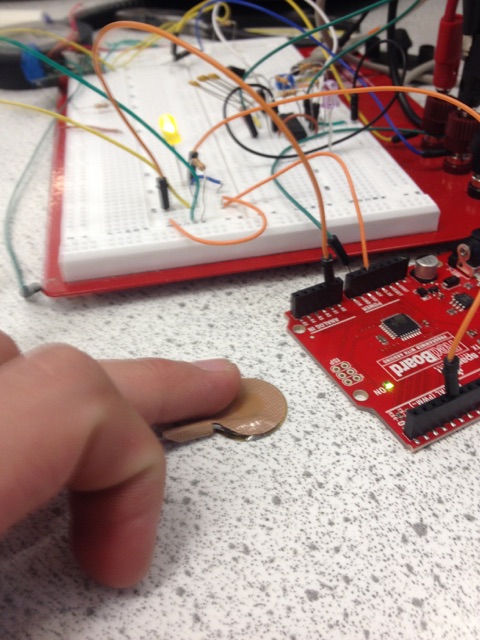This inspiration for my project was the Rock Band drum set. I read that these drum sets can be used for a bunch of different projects pretty easily, and have quite a few decent piezoelectric sensors inside. So, to start off, I disassembled the drum set to see what all was inside.

The first accessible screws are on the bottom of the unit near the battery pack. At this point, I wasn’t too sure what the insides of the unit looked like at all. The unit seems too have bee designed with assembly in mind – all of the screws (Phillips) are the same head size, and most are the same lengths. This made the initial disassembly pretty convenient.
 When I opened up the back I found a few PCB’s with some wires running out. At this point I realized that the sensors I was interested in may not be fully accessible from this route. There weren’t any other obvious screws for disassembly, so I had to figure out how the uint was put together. Each of the drum pads appeared to be connected via some sort of rubber stopper that comes out of the bottom of the assembly. My first thought was to just try to pull the bottom of the stopper out and cut it (its a rubber cone pressed through a hole so that it can’t be pulled out). However, after removing one drum pad this way, I figured it might be a good idea to try and not damage the pieces in case I want to re-assemble the set for some reason. So, instead, I used the screwdriver to force the cones back through the holes (just takes a little force).
When I opened up the back I found a few PCB’s with some wires running out. At this point I realized that the sensors I was interested in may not be fully accessible from this route. There weren’t any other obvious screws for disassembly, so I had to figure out how the uint was put together. Each of the drum pads appeared to be connected via some sort of rubber stopper that comes out of the bottom of the assembly. My first thought was to just try to pull the bottom of the stopper out and cut it (its a rubber cone pressed through a hole so that it can’t be pulled out). However, after removing one drum pad this way, I figured it might be a good idea to try and not damage the pieces in case I want to re-assemble the set for some reason. So, instead, I used the screwdriver to force the cones back through the holes (just takes a little force).
This lead to the piezoelectric sensor assembly. The top of the sensor is pressed to the bottom of the drum pad, and held in place by a spring and supporting member. The bottom of the drum pad is insulated with a soft foam to reduce noise to the other sensors from drum hits. This is a pretty good looking system that appears to work pretty well, so I’ll probably end up using a similar system in my design.

I initially thought that I might be using some of the native circuitry from the rock band set in my project. However, after taking apart one of the drum pads, I realized this wasn’t necessary. If I cut the wires from the piezoelectric sensor, I can hook them up to a microcontroller directly. This is a lot less confusing, and removes a lot of possible error on my part, so I proceeded to remove the rest of the sensors.
Finally, I wanted to get some code up and running, so even though I don’t have my teensy yet (should arrive this week) I hooked up to of the drum pads to an Arduino RedBoard t0 see if I could get something functional. I ended up just having each of the drum pads flip the state of an LED when struck. It worked pretty well, but I’m still a little worried about using “if” statements for four sensors. Instead, I’ll need to figure out how to use either interrupts, or some other system to make sure everything is running smoothly.


2 Comments. Leave new
The force sensors in the rock band drum heads got me interested in what sort of sensors you can buy, and about the human interaction with audio in general. I was hoping to find a force sensor pad that could output how hard and where on the pad it was hit. This would give an extra element of user input and control. Unfortunately, force sensors only output a resistive value across the surface, and can’t give any positional location of where the force is being applied (something like https://www.sparkfun.com/products/9376). My next thought was that you could use a soft potentiometer strip as a slider input (a super long one: https://www.sparkfun.com/products/8681 short: https://www.sparkfun.com/products/8680). It could be a really interesting audio experience to manipulate output audio with a whole bunch of sliders on a panel. You’ll definitively need to do some playing around with a bunch of sensors hooked up at once, and see what sort of response times you get. Constantly polling all of the force sensors may not be fast enough to reliably get all of the inputs. I wonder if the Rock Band circuitry was doing some sort of hardware filter/ADC and timing so that the required processing is less. It is actually pretty amazing how well those things work (given that they have to be able to register accurately enough to know if you are in time with the song).
I remember being pleasantly surprised with the ease of connecting these devices to arduinos. We did a similar thing for measurements last semester. Reach out to Kyle Samples (or I can too) if you need any of our experience.